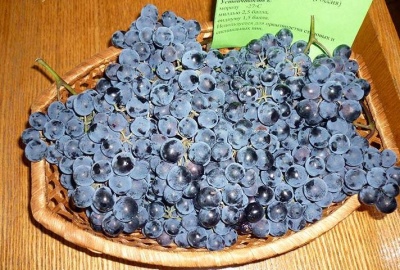
- Authors: VNIIViV them. ME AND. Potapenko, Russia
- Appointment: technical
- Berry color: dark blue
- Taste: harmonious, with a very weak nutmeg aroma
- Ripening period: early middle
- Ripening period, days: 128-130
- Frost resistance, ° C: -24
- Bunch weight, g: 110-120
- Yield: 100-110 c / ha
- Flower type: bisexual
Augusta grapes are considered one of the best varieties for central Russia. This is an early variety with good frost resistance and average yield. The technical grade is used for the production of nectars, juices, dessert and dry wines.
Breeding history
It was obtained in 1998 by the All-Russian Research Institute of Viticulture and Winemaking named after Ya. I. Potapenko when crossing the French hybrid SV 12-309 with the domestic hybrid Kazachka.
Geography of distribution
The North Caucasus region, Ukraine, the southern regions of Russia, for cultivation in the middle lane, it is recommended to cover for the winter. There is information about planting and fruiting in Siberia.
Description
The bushes are vigorous, the root system is very powerful. The leaf is solid, rounded, three-lobed, reticulate-wrinkled, with denticles in the form of a dome. The leaf plate is light green smooth, the petioles are red-brown. The plant grows very quickly, the dense leaves create significant shading. Differs in 100% ripening of shoots. Flowering begins in late May - early June.
Ripening period
The ripening period is 130 days. For the production of dry wine, you can harvest at the end of August. For dessert wines, the bunches are left to hang on the vine until early September.
Bunches
Small, weighing about 110-120 g. Conical in shape, loose in density.
Berries
Small, rounded, dark blue with a characteristic bluish waxy coating. The mass is about - 1.3 g. The pulp is fleshy and juicy, the juice is not colored, there are small bones.
Taste
Sweet and sour harmonious taste with a light nutmeg aroma. Sugar content - 23-27%, acid - 9 g / l.
Yield
The variety is considered high-yielding, brings from 8 to 10 kg per bush, there is information that up to 100-110 centners of berries can be removed from one hectare.


Growing features
The vines must be tied to a trellis or other support. During flowering, it is necessary to normalize the number of brushes on the lash; foliage is removed around the bunches. The plant needs frequent pruning. It is necessary to weed from weeds, loosen the soil after watering, mulch.
Landing
August takes root well. Choose a place on the south side, protected from the wind. Prefers black soil, sandy loam and light loamy soils. They are planted in spring, the air should warm up to +10 degrees. The layout is 3x1.5 m. After planting, the seedlings are covered with a film, when shoots appear in the film, holes are cut.

Pollination
It blooms with male and female flowers. Able to self-pollinate. With artificial pollination, the yield increases several times.
Pruning
The length of the vine should not exceed 180 cm. During the period of pouring the berries, the green tops on all vines are cut off. Some of the leaves are also recommended to be removed - they interfere with ventilation, shade the bunches. Be sure to cut short shoots that are less than 10 cm.
The main pruning is carried out in the fall after the foliage has fallen and the onset of the first frost. On the bush, 20-25 eyes are usually left, cut off by 3-4 eyes.

Watering
It should be moistened often: not flooding the plant, but providing it with water to the fullest. Water with settled water is the same as the air temperature on the site, about 2 times a week. Watering is stopped 2 weeks before ripening. Do not water during the rains.


Top dressing
The first feeding is carried out in June or early July with a superphosphate solution (200 g per 3 liters of water). The second time - in early August, mixing ammonium nitrate (30 g), boric acid (10 g), potassium sulfate (100 g) with 2 liters of water. The resulting composition is sprayed on the foliage on both sides, sprayed again every other day, but with clean water. This procedure is best done in calm weather. In autumn, they are fed with liquid organic fertilizers.
Frost resistance and the need for shelter
Withstands temperatures down to -25, but gardeners recommend sheltering grapes for the winter in central Russia.

Diseases and pests
The variety is resistant to a number of diseases: mildew - 2.5 points, phylloxera - 3.5 points.
May be affected by gray mold or chlorosis. Diseased shoots and leaves are removed and destroyed. To eradicate gray rot, use "Benleit", "Topsin", "Euparen". Processed: after the flowers fall, then before the berries close in the brush, two more times: at the beginning of ripening and 1 month before harvesting.
Against chlorosis, drugs are used "Mikom" or "Antichlorosin". Before flowering, spray with a 0.1% solution, after completion - 0.15%, for the next 2 treatments, use a 0.2% solution.
Fruit rot may appear before harvest. To treat infected areas, a solution of potassium permanganate, a mixture of iodine with potassium or baking soda is used.
Of the pests are dangerous: aphids, scale insects, leafworms. Spraying with drugs "Karbofos", "Anometrin", "Fozalon", "Mitak" is effective.

If a grape is exposed to any disease or insect, this always affects its appearance.
Storage
Ripe grapes can be stored in a cool room on a rope, hanging in several rows, or in boxes lined with clean paper. Store for 1.5-2 months, periodically checking if the berries have deteriorated.











































































